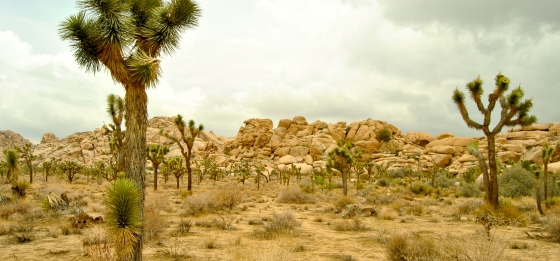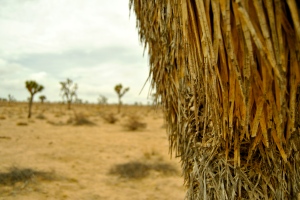July 21-22
Joshua Tree National Park, California
The desert has much to teach us about the marvels of adaptation. Relentless sun, little water, and summer temperatures over 100 degrees Fahrenheit can make a forbidding world for non-desert dwellers. Yet hundreds of species conserve moisture and beat the heat in fascinating ways. –Joshua Tree National Park visitor’s map
Sweltering July is the off-season at Joshua Tree National Park, home to the unique ecological meeting point of the Colorado and Mojave Deserts. We entered the Park’s South Entrance and spent the night under a full moon at the nearly empty Cottonwood Spring campground. We woke up at 5:30 a.m. for a morning hike, and atop Mastodon Peak, we gazed out over a landscape full of contractions: the desert is smooth yet angular, monochrome yet motley, barren yet overflowing. But it wasn’t until later that afternoon driving west to higher elevations that we encountered the park’s namesake and perhaps the most paradoxical fixture on the landscape: the Joshua tree.
Face-to-face with a Joshua tree, it’s hard to decide whether it’s beautiful or hideous. Either way, though, there is much more to the Joshua tree than meets the eye. In a children’s book published by the National Park Service as an educational tool, author L.S. Lange describes the keystone species role the Joshua tree plays. The Gambel’s quail eats its seeds, the Scott’s oriole nests in its leaves and feeds on its nectar, loggerhead spike birds spear their prey on its sharp leaves, Yucca moths hatch in its seed pods, and termites live in the decomposing trunks.
What would Joshua Tree National Park be without the Joshua tree? The Park Service is trying to prevent us from having to find out.
The everywhere-nowhere tree
When we had asked Ken Cole, a retired U.S. Geological Survey ecologist who studied the species, where we could find the best Joshua tree forests he told us, “there just aren’t that many Joshua trees in Joshua Tree National Park.”
According to Cole’s 2011 research, there probably were Joshua trees in the southern part of the park 11,700 years ago. Paleoclimatological records suggest that the tree’s range shrank by 90 percent when the climate warmed up four degrees Celsius over 50 years, marking the end of the Pleistocene and the start of the Holocene. With the warming, an important seed-dispersing Shasta ground sloth disappeared. Trees now only occupy the highest altitudes of that original range, where temperatures are cooler.
“Joshua trees are very picky. They tend to hang around at 3,500 to 5,000 foot elevation,” Park Association employee Lacy Ditto told us.
In certain parts of the park, though, the Joshua trees are ubiquitous. After easing our minivan up a 2,000-foot climb into the Mojave, scraggly Joshua trees of all different shapes and sizes surrounded us—at 40 feet stood the tallest Joshua tree in the world. Others stooped, overloaded with branches. Old, dead Joshua trees lay defeated on the harsh desert floor. Many trees were teeming with the remnants of pods that, after a very rare full bloom this spring, were dropping millions of seeds to vie for germination below.
And whether this rare abundance is a sign of regeneration or impending decline is the latest mystery of the Joshua tree.
Bounty, or last chance?
This year’s bloom in Joshua Tree National Park was the most bountiful in decades—40 percent bigger than the next best bloom in the past 25 years. And this could be a good thing, since the species has been having a difficult time reproducing lately. Reproduction has dropped by about 30 percent throughout the park, and in the hottest and driest areas, the Joshua tree hasn’t been regenerating at all. In many parts of the park, the death rate of its namesake has been outstripping the birth rate for decades.
Why the trouble in paradise? Some point to the warmer nights in the winter. Some think the tree needs a cold winter frost to damage its growing tips, which jolts it into flower production. The fertility challenges may also be linked to the Yucca moth, an important Joshua tree pollinator that could be sensitive to higher temperatures. No one really knows for sure.
Experts also aren’t sure whether the recent flowery outpouring of the Joshua trees in the park is cause for celebration or alarm. According to Josh Hoines, a National Park Service vegetation specialist, several anecdotal theories exist as to why the trees flowered so successfully this year. One is that there was a cold snap and some snow this winter. Another is that more rainfall allowed for extra resource accumulation—especially after two years of drought.
Hoines described a third possible explanation: “The most recent theory I have seen is that the climate has moved to the edge of the physiologic tolerance for Joshua trees and they are putting out one last ditch effort before they die.”
Climate models suggest we can expect an increase in temperatures around four degrees Celsius in the next 60 to 90 years—a similar rate of change to 11,700 years ago. Using scenario-based modeling, Cole and his research team predict that the tree’s range will constrict to 10 percent of its current area as temperatures rise.
“We think the change with global warming will be similar in scale to the last major die-off. 90 percent of the current range may disappear,” Cole said.
Keeping the Joshua tree

Joshua trees are full of mysteries. Because they don’t have tree rings, scientists have a very hard time estimating their age.
Amid media hoopla about the future of the Joshua tree and speculation as to what the big bloom could mean, many researchers and Park Service specialists are taking action to protect the species despite imperfect information. While researchers work to fill in important science gaps about the Joshua tree, vegetation specialists like Hoines are implementing ‘no regrets’ strategies. They collect and store seeds in a bank and use them to revegetate sites that are degraded. The Park also runs a nursery where specialists grow the temperature-sensitive seedlings in a controlled environment before they are restored to the Park. Park employees monitor long-term plots to better understand how the trees respond to climate change.
Some researchers are beginning to think about a more controversial solution: manually relocating the Joshua tree. Cole’s study identified new areas that could provide an appropriate climate for the Joshua tree as the climate changes. Of these areas, those that fall within two kilometers of current Joshua tree populations could be suitable for natural migration, where seed dispersers might move the populations naturally. But most of the future favorable climates fall further than two kilometers away from current Joshua tree populations, and would require managed relocation: people dispersing seed or planting seedlings. Many of these suitable areas are already federally protected, so the plan may be feasible. Whether or not it is palatable for the Park Service and other Federal agencies to intervene in this way is another question—and they’re certainly trying out other tools in the toolkit first.

Cole et al. 2011 show the areas where Joshua trees will likely die out (red), the areas where they could naturally migrate (yellow), and the areas that could be considered for assisted relocation (green)
While these quiet efforts to protect the Joshua tree don’t often make headlines, careful research and management may be what ultimately prevent the doomsday declarations from coming true. If the Joshua tree leaves the Park, it won’t be without a fight.
“The Joshua tree is not going extinct. We’re not going to let that happen,” said Ditto.










Pingback: Preventing a Joshua Treeless National Park | Fr...
Pingback: The Many Small Ways Americans Are Adapting to Climate Change | TokNok Multi Social Blogging Solutions